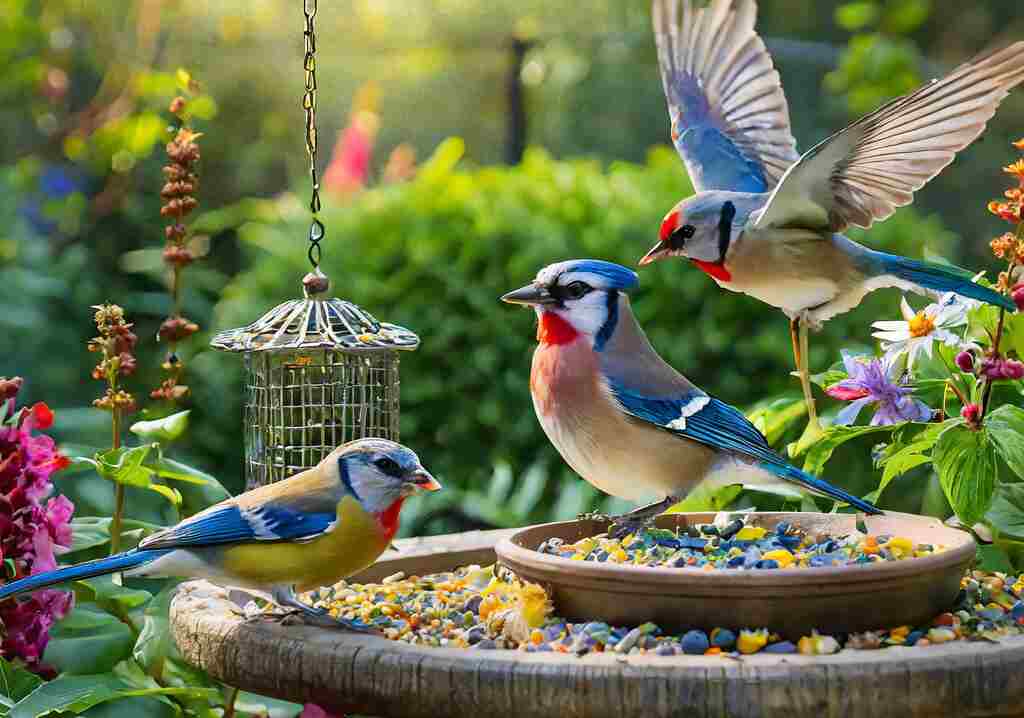
Birds are a delightful addition to any garden, bringing color, song, and life to your outdoor space. Whether you’re a seasoned birdwatcher or a gardening enthusiast looking to enhance your backyard ecosystem, attracting birds to your garden can be a rewarding and enriching experience. This comprehensive guide will walk you through various strategies and techniques to transform your garden into a haven for our feathered friends.
Table of Contents
- 1 Understanding the Basics of Bird Attraction
- 2 Creating a Bird-Friendly Landscape
- 3 Providing Food Sources
- 4 Providing Water Sources
- 5 Providing Shelter and Nesting Sites
- 6 Creating a Safe Environment
- 7 Enhancing Your Bird-Watching Experience
- 8 Seasonal Considerations
- 9 Advanced Bird Attraction Techniques
- 10 Participating in Citizen Science Projects
- 11 Dealing with Common Challenges
- 12 The Role of Birds in Garden Ecosystems
- 13 Photographing Birds in Your Garden
- 14 Building a Community of Bird Enthusiasts
- 15 Conclusion
- 16 Author
Understanding the Basics of Bird Attraction
Before diving into specific strategies, it’s essential to understand what birds need to thrive in your garden. Birds, like all living creatures, have four basic requirements:
- Food
- Water
- Shelter
- Nesting sites
By addressing these fundamental needs, you’ll create an environment that not only attracts birds but encourages them to stay, potentially even breeding in your garden.
Creating a Bird-Friendly Landscape
The first step in attracting birds to your garden is to create a landscape that appeals to them. This involves choosing the right plants, designing your garden layout, and maintaining a healthy ecosystem.
Choosing the Right Plants
Native Plants: One of the most effective ways to attract birds is by planting native species. Native plants have co-evolved with local bird populations, providing them with familiar food sources and habitats. Research the native plants in your area and incorporate them into your garden design.
Variety is Key: Different bird species have different preferences, so aim for a diverse range of plants. Include:
- Trees: Oaks, maples, and pines provide nesting sites and food.
- Shrubs: Elderberry, serviceberry, and dogwood offer berries and shelter.
- Flowers: Sunflowers, coneflowers, and asters provide seeds.
- Grasses: Switchgrass and bluestems offer seeds and nesting material.
Year-Round Interest: Plan your garden to provide food and shelter throughout the year. Include plants that produce berries in winter, flowers that bloom in spring and summer, and seed-bearing plants for fall.
Designing Your Garden Layout
When planning your garden layout, consider the following:
Layers: Create a multi-layered habitat that mimics natural environments. Include ground cover, shrubs, understory trees, and canopy trees.
Open Areas: Leave some open spaces in your garden for ground-feeding birds like robins and sparrows.
Dense Areas: Provide dense shrubs or thickets for birds to hide and nest in.
Edges: Many birds prefer edge habitats, where different types of vegetation meet. Create these transitions in your garden.
Maintaining a Healthy Ecosystem
A bird-friendly garden is a healthy garden. Avoid using pesticides and herbicides, as these can harm birds directly or eliminate their food sources. Instead, embrace natural pest control methods and tolerate some imperfections in your plants.
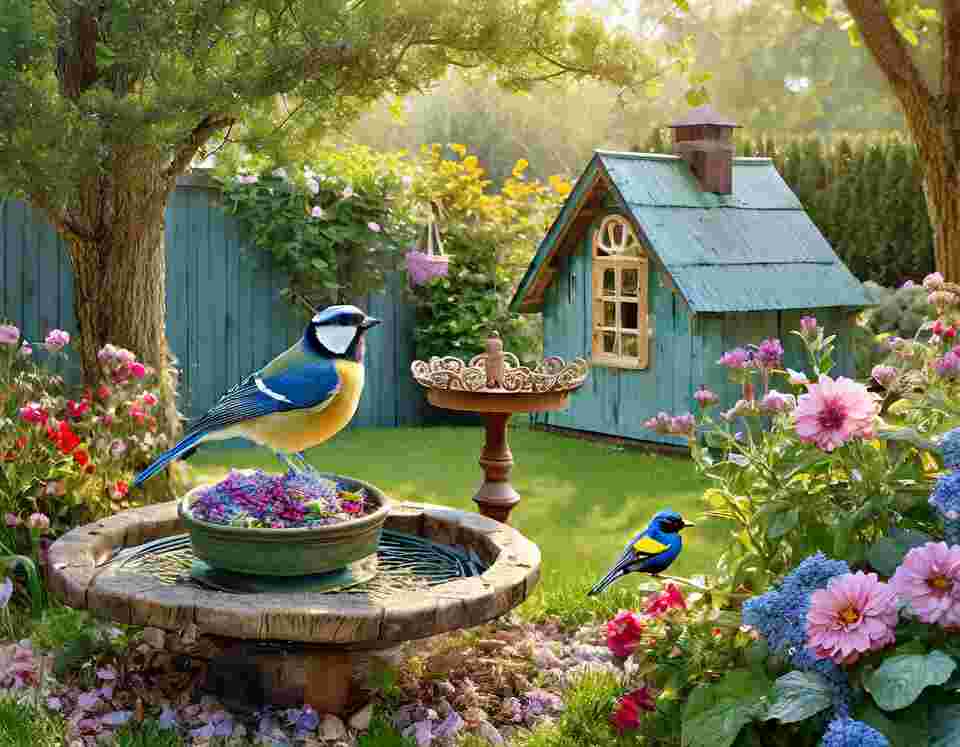
Providing Food Sources
While native plants are an excellent long-term strategy for feeding birds, supplementary feeding can attract a wider variety of species and provide crucial support during harsh weather conditions.
Bird Feeders
There are many types of bird feeders available, each designed to attract different species:
- Platform Feeders: These open trays attract a wide variety of birds and can be placed on the ground or elevated.
- Hopper Feeders: These enclosed feeders protect seeds from the elements and are ideal for larger birds like cardinals and jays.
- Tube Feeders: Long, cylindrical feeders with multiple feeding ports are perfect for small birds like finches and chickadees.
- Suet Feeders: These cage-like feeders hold suet cakes, attracting woodpeckers, nuthatches, and other insect-eating birds.
- Nyjer Feeders: These have tiny ports that dispense nyjer seeds, a favorite of goldfinches and siskins.
Types of Bird Food
Different birds prefer different types of food. Here’s a guide to some common bird foods:
| Food Type | Attracted Birds |
|---|---|
| Black Oil Sunflower Seeds | Cardinals, chickadees, finches, nuthatches |
| Safflower Seeds | Cardinals, grosbeaks, chickadees |
| Nyjer Seeds | Goldfinches, siskins, redpolls |
| Suet | Woodpeckers, nuthatches, chickadees, wrens |
| Fruit (apples, oranges, grapes) | Orioles, tanagers, mockingbirds |
| Mealworms | Bluebirds, robins, wrens |
Feeding Tips
- Consistency: Once you start feeding birds, try to maintain a consistent schedule. Birds may come to rely on your feeders, especially during winter.
- Cleanliness: Regularly clean your feeders to prevent the spread of diseases among birds.
- Placement: Position feeders near natural shelter like trees or shrubs, but not too close to allow predators to hide.
- Variety: Offer a variety of foods to attract different species.
Providing Water Sources
Water is essential for birds, not just for drinking but also for bathing. A reliable water source can be a powerful attractant for birds, especially in dry or urban areas.
Bird Baths
Bird baths are the most common way to provide water for birds. When choosing or designing a bird bath, consider the following:
- Depth: The water should be no more than 1-2 inches deep at its deepest point. Many birds prefer shallow water.
- Texture: The bottom of the bath should have a rough texture to provide good footing for birds.
- Size: A bath with a diameter of 2-3 feet is ideal for most gardens.
- Height: Place the bath about 2-3 feet off the ground to protect birds from predators.
Moving Water
Birds are particularly attracted to the sound and sight of moving water. Consider adding a fountain or dripper to your bird bath. This not only attracts birds but also helps keep the water fresh and prevents mosquito breeding.
Maintenance
- Clean Regularly: Change the water every few days and scrub the bath to prevent algae growth and disease transmission.
- Winter Care: In cold climates, use a bird bath heater to prevent freezing and provide a crucial water source during winter.
Providing Shelter and Nesting Sites
Birds need safe places to rest, hide from predators, and raise their young. By providing a variety of shelter options, you can attract more birds and encourage them to stay in your garden.
Natural Shelter
- Trees and Shrubs: Dense vegetation provides excellent cover for birds. Evergreens are particularly valuable as they offer year-round shelter.
- Brush Piles: Create a pile of branches and leaves in a corner of your yard. This provides shelter for ground-dwelling birds and insects that birds feed on.
- Dead Trees: If safe to do so, consider leaving dead trees or “snags” standing. These provide nesting sites for cavity-nesting birds and attract insects for birds to eat.
Birdhouses
Birdhouses, also known as nest boxes, can attract a variety of cavity-nesting birds. Different species prefer different types of houses:
- Bluebird Houses: Should have a 1.5-inch entrance hole and be placed 5-6 feet high in open areas.
- Wren Houses: Need a 1-inch entrance hole and can be placed 5-10 feet high in partially shaded areas.
- Purple Martin Houses: These are multi-compartment houses that should be placed 15-20 feet high in open areas.
- Owl Boxes: Large boxes with 6-inch entrance holes, placed 10-20 feet high on trees or poles.
When installing birdhouses, consider the following:
- Placement: Face the entrance hole away from prevailing winds and direct sunlight.
- Spacing: Most birds are territorial, so space houses for the same species at least 25 feet apart.
- Maintenance: Clean out old nests in late winter before the new breeding season starts.
Nesting Material
Provide nesting material to encourage birds to build nests in your garden:
- Offer small twigs, grass clippings, and leaves in a suet cage or mesh bag.
- Leave areas of your garden slightly unkempt to provide natural nesting materials.
- Avoid using dryer lint or human hair, as these can be harmful to birds.
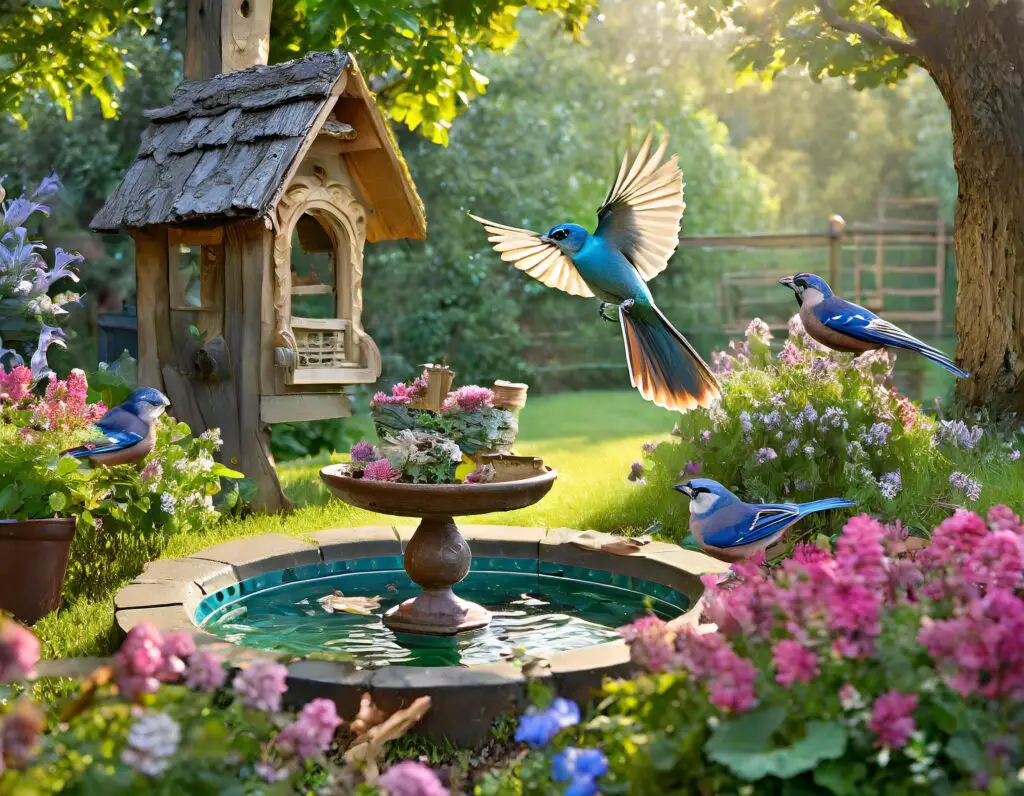
Creating a Safe Environment
While attracting birds to your garden is rewarding, it’s crucial to ensure that your garden is a safe haven for them.
Reducing Window Collisions
Window collisions are a major cause of bird fatalities. To reduce this risk:
- Use Window Decals: Apply specially designed decals or strips to your windows to make them visible to birds.
- External Screens: Install external screens on windows to soften the impact if a bird does fly into them.
- Reduce Reflections: Close blinds or curtains to reduce reflections that can confuse birds.
Managing Pets
If you have cats or dogs, take steps to protect birds:
- Keep cats indoors, especially during dawn and dusk when birds are most active.
- Use a collar with a bell on outdoor cats to warn birds.
- Supervise dogs in the garden, especially during nesting season.
Avoiding Harmful Chemicals
As mentioned earlier, avoid using pesticides and herbicides in your garden. These can harm birds directly or eliminate their food sources. Instead:
- Use organic gardening methods.
- Encourage natural predators like ladybugs and praying mantises.
- Hand-pick pests or use physical barriers to protect plants.
Enhancing Your Bird-Watching Experience
Once you’ve created a bird-friendly garden, you’ll want to enjoy the fruits of your labor. Here are some tips to enhance your bird-watching experience:
Identification Tools
- Field Guides: Invest in a good field guide specific to your region.
- Binoculars: A decent pair of binoculars will help you observe birds without disturbing them.
- Mobile Apps: Many apps can help with bird identification and even record your sightings.
Creating Viewing Areas
Designate areas in or near your house for bird watching:
- Set up a comfortable seating area with a good view of your feeders and bird baths.
- Consider installing a large window or glass door overlooking your garden.
Record Keeping
Keep a checklist and or journal of the birds you see in your garden. Note species, dates, and any interesting behaviors. This can be a rewarding long-term project and help you track the success of your bird-attraction efforts.
Seasonal Considerations
Different seasons bring different bird-related challenges and opportunities:
Spring
- Clean and prepare nest boxes for the breeding season.
- Provide nesting materials.
- Plant annuals that will provide seeds in late summer and fall.
Summer
- Maintain water sources, especially during hot weather.
- Continue offering food, but expect less activity at feeders as natural food is abundant.
- Avoid pruning trees and shrubs during nesting season.
Fall
- Leave seed heads on flowers for birds to feed on.
- Plant trees and shrubs that will provide shelter and food sources.
- Clean and repair feeders and bird baths in preparation for winter.
Winter
- Provide high-energy foods like suet and sunflower seeds.
- Keep water sources from freezing.
- Leave some areas of your garden “messy” to provide shelter and foraging opportunities.
Advanced Bird Attraction Techniques
As you become more experienced in attracting birds to your garden, you might want to try some advanced techniques to draw in a wider variety of species or to create more specialized habitats.
Creating a Butterfly Garden to Attract Insectivorous Birds
Many birds feed on insects, and butterflies can be an important part of their diet. By creating a butterfly garden, you can attract both butterflies and the birds that feed on them. Here are some tips:
- Plant nectar-rich flowers like butterfly bush, zinnias, and lantana.
- Include host plants for butterfly caterpillars, such as milkweed for monarchs.
- Provide shallow puddles or water sources for butterflies.
- Avoid using pesticides in this area.
Mimicking Natural Soundscapes
Birds are often attracted to the sounds of other birds and natural water features. You can use this to your advantage:
- Install a small waterfall or fountain to create the sound of running water.
- Use bird call recordings sparingly to attract specific species (be careful not to overuse this technique as it can disturb nesting birds).
- Plant grasses and plants that make pleasant rustling sounds in the wind.
Creating Micro-Habitats
Different bird species prefer different types of habitats. By creating various micro-habitats within your garden, you can attract a more diverse range of birds:
- Wetland Area: If space allows, consider creating a small pond or bog garden to attract wetland birds.
- Wildflower Meadow: Dedicate an area of your garden to wildflowers to attract seed-eating birds and insect-eaters.
- Rock Garden: Create a rocky area with drought-resistant plants to attract birds that prefer arid environments.
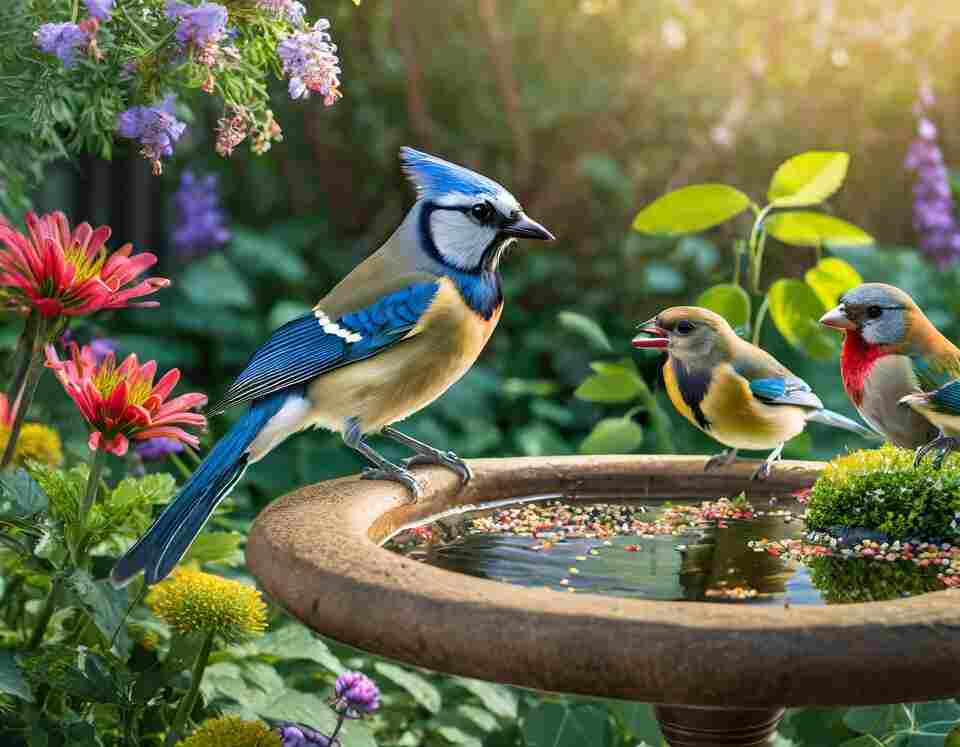
Participating in Citizen Science Projects
Your bird-friendly garden can contribute to scientific research and conservation efforts. Many organizations run citizen science projects that rely on data from backyard birdwatchers. Here are a few you might consider participating in:
- Project FeederWatch: Run by the Cornell Lab of Ornithology, this project asks participants to count birds at their feeders from November to April.
- Great Backyard Bird Count: An annual four-day event in February where birdwatchers count birds to create a real-time snapshot of bird populations.
- NestWatch: This project involves monitoring bird nests to collect data on breeding birds.
- eBird: A year-round project where you can report bird sightings anytime, anywhere.
Participating in these projects not only contributes to scientific knowledge but also helps you learn more about the birds in your garden and how they fit into the broader ecosystem.
Dealing with Common Challenges
Even the most well-designed bird-friendly garden can face challenges. Here are some common issues and how to address them:
Squirrels Raiding Feeders
Squirrels can be persistent in their efforts to access bird feeders. Try these strategies:
- Use squirrel-proof feeders with weight-activated perches that close when a squirrel tries to access them.
- Place feeders on poles with squirrel baffles.
- Offer foods that squirrels don’t prefer, like safflower seeds or nyjer seeds.
Aggressive Birds Dominating Feeders
Sometimes, certain bird species can monopolize feeders, driving away smaller or more timid birds. To address this:
- Use multiple feeder types spread around your garden to cater to different species.
- Provide some ground feeding areas for birds that prefer to feed there.
- Use feeders with short perches that larger birds find difficult to use.
Cats and Other Predators
While we’ve touched on this earlier, here are some additional strategies to protect birds from predators:
- Place thorny plants like roses or pyracantha around the base of bird feeders and nesting areas.
- Use ultrasonic devices to deter cats (but be aware these may also affect other wildlife).
- Consider building a “catio” for your cats to enjoy outdoor time safely.
The Role of Birds in Garden Ecosystems
Understanding the vital role birds play in your garden ecosystem can deepen your appreciation for these feathered visitors and motivate you to continue improving your bird-friendly habitat.
Natural Pest Control
Many birds are voracious insect eaters, helping to keep pest populations in check naturally. For example:
- Chickadees and warblers feed on aphids, scale insects, and whiteflies.
- Woodpeckers and nuthatches eat wood-boring insects that can damage trees.
- Swallows and swifts catch flying insects on the wing, helping to control mosquito populations.
By attracting these birds to your garden, you’re enlisting a free, natural pest control service.
Pollination
While bees and butterflies are often celebrated as pollinators, many birds also play this crucial role. Hummingbirds, in particular, are important pollinators for many plant species. Some flowers have even evolved specifically to attract bird pollinators, with tubular shapes perfectly suited to a hummingbird’s long beak.
Seed Dispersal
Birds play a crucial role in dispersing seeds, which helps maintain plant diversity and can even aid in reforestation efforts. As birds eat fruits and berries, they disperse the seeds through their droppings, often far from the parent plant. This process, known as ornithochory, is vital for maintaining healthy ecosystems.
Photographing Birds in Your Garden
Once you’ve successfully attracted birds to your garden, you might want to capture their beauty through photography. Here are some tips for photographing birds in your garden:
- Use a Long Lens: A telephoto lens (at least 200mm) will allow you to get close-up shots without disturbing the birds.
- Set Up Near Feeders or Baths: These areas of high bird activity are great for photography.
- Create Natural-Looking Perches: Place attractive branches near your feeders to create more natural-looking photos.
- Use a Fast Shutter Speed: Birds move quickly, so a shutter speed of at least 1/1000th of a second is often necessary to freeze the action.
- Be Patient: Wildlife photography requires patience. Set up your camera and wait quietly for the birds to become comfortable with your presence.
- Consider the Background: A clean, out-of-focus background can make your bird photos more attractive. Position yourself to achieve this effect.
- Respect the Birds: Always prioritize the birds’ wellbeing over getting a photo. Avoid actions that might stress or disturb the birds.
Building a Community of Bird Enthusiasts
Attracting birds to your garden can be even more rewarding when shared with others. Consider these ideas for building a community around your bird-friendly garden:
- Host a Garden Tour: Invite neighbors and local garden clubs to tour your bird-friendly garden. Share your knowledge and inspire others to create their own bird habitats.
- Start a Local Bird Club: Connect with other bird enthusiasts in your area to share experiences, go on bird walks, and work on conservation projects together.
- Educate Children: Offer to give talks at local schools about birds and the importance of creating bird-friendly spaces. Children who develop an early appreciation for birds often become lifelong conservationists.
- Use Social Media: Share photos and observations from your garden on social media platforms. This can help raise awareness about local bird species and inspire others to create bird-friendly spaces.
- Participate in Local Conservation Efforts: Get involved with local nature centers or Audubon chapters to contribute to broader bird conservation efforts in your community.
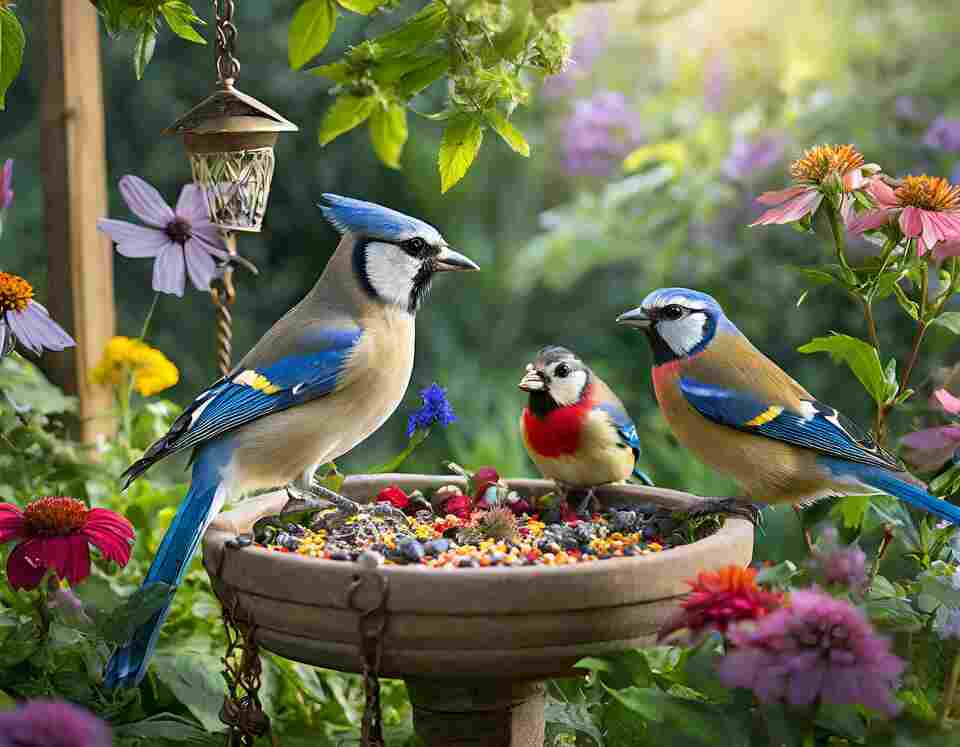
Conclusion
Creating a bird-friendly garden is a journey that requires patience, observation, and a willingness to work with nature. By providing food, water, shelter, and nesting sites, you can transform your garden into a vibrant ecosystem that supports a diverse array of bird species.
Remember that attracting birds is not just about providing for their needs, but also about creating a harmonious environment where birds can thrive alongside other wildlife and plants. As you implement these strategies, take time to observe and enjoy the birds that visit your garden. Each species has its own unique behaviors and preferences, and learning about them can deepen your appreciation for these fascinating creatures.
With time and effort, your garden can become a sanctuary for birds, providing you with endless opportunities for learning, enjoyment, and connection with nature. Whether you’re watching a hummingbird sip nectar from a flower you planted, or listening to a chorus of songbirds on a spring morning, the rewards of a bird-friendly garden are truly priceless.
So grab your gardening gloves, pick up that birding guide, and start transforming your outdoor space into a haven for our feathered friends. Your efforts will not only benefit the birds but will also contribute to the broader conservation of bird species and the enrichment of your local ecosystem. Happy bird gardening!

